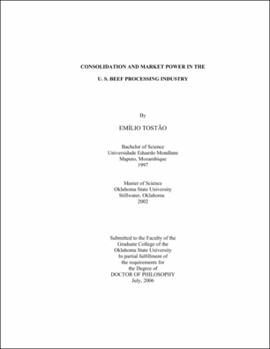| dc.contributor.advisor | Chung, Chanjin | |
| dc.contributor.author | Tostao, Emilio | |
| dc.date.accessioned | 2013-11-26T08:22:06Z | |
| dc.date.available | 2013-11-26T08:22:06Z | |
| dc.date.issued | 2006-07 | |
| dc.identifier.uri | https://hdl.handle.net/11244/6545 | |
| dc.description.abstract | Scope and Methods of Study: This study contains two essays. The purpose of the first essay was to separate processors' potential market power from retailers' potential market power. Pricing rules for processors and retailers were derived considering three scenarios of imperfect competition: bilateral oligopoly assuming that processors and retailers are integrated in one sector, successive oligopoly with processor oligopsony power, and successive oligopsony with retail oligopoly power. The model was used to estimate the tradeoffs between market power and cost savings from increased concentration in the U.S. beef processing industry. The purpose of the second essay was to determine the relationship between auction and traditional new empirical industrial organization (NEIO) models of market power, and examine their relative accuracies. A theoretical model considering auction-level and market-level markdowns was used to show the relationship between the two models of measuring market power. Relative accuracy is measured by comparing the markdowns estimated using both models with "true" markdowns from an experimental cattle market. The traditional NEIO measure of market power was tested against the auction measure of market power using non-nested hypothesis tests. | |
| dc.description.abstract | Findings and Conclusions: Results from the first essay showed that processor's market power effects were smaller when retailers were considered separately from processors. Processors potential efficiency gains were also small, but exceeded market power effects slightly. Therefore, further increase in concentration could lead to market power effects greater than the cost saving effects. Results showed the importance of considering processors' potential market power separately from retailers' potential market power in estimating the effects of the increased concentration in the U.S. food industry. Theoretical results from the second essay showed neither NEIO nor auction theories fully describe market power in cattle markets. Using data from an experimental cattle market it was found that both NEIO and structural auction models yield predictions of price markdowns close to actual. However, results from hypothesis tests indicated that either theory did not sufficiently explain price markdown behavior in the cattle procurement market. Theoretical results were consistent with empirical results. | |
| dc.format | application/pdf | |
| dc.language | en_US | |
| dc.rights | Copyright is held by the author who has granted the Oklahoma State University Library the non-exclusive right to share this material in its institutional repository. Contact Digital Library Services at lib-dls@okstate.edu or 405-744-9161 for the permission policy on the use, reproduction or distribution of this material. | |
| dc.title | Consolidation and market power in the U.S. beef processing industry | |
| dc.contributor.committeeMember | Brorsen, B. Wade | |
| dc.contributor.committeeMember | Ward, Clement E. | |
| dc.contributor.committeeMember | Warde, William D. | |
| osu.filename | Tostao_okstate_0664D_1963 | |
| osu.accesstype | Open Access | |
| dc.type.genre | Dissertation | |
| dc.type.material | Text | |
| thesis.degree.discipline | Agricultural Economics | |
| thesis.degree.grantor | Oklahoma State University | |
